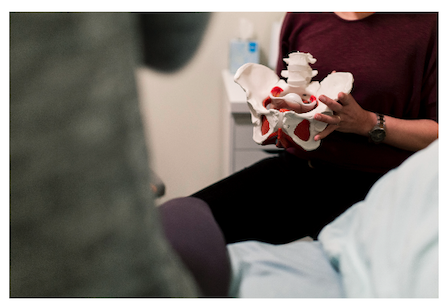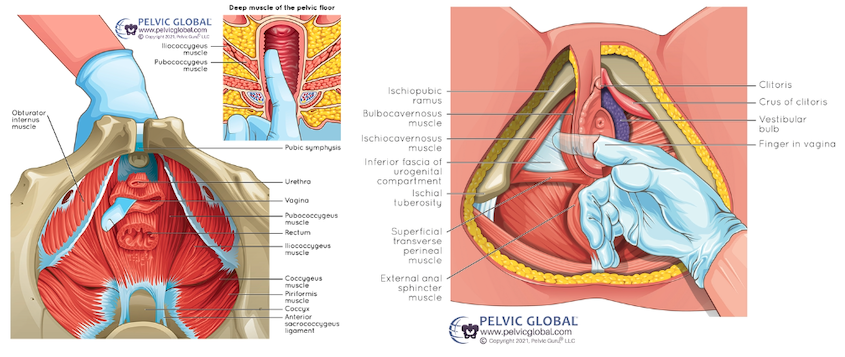Demystifying the Pelvic Floor – How Physical Therapy Can Help
No one really notices their pelvic floor muscles until something goes wrong with one of its functions. I hope you are reading this just for information; however, if you are reading this blog because you think something may be wrong with your pelvic floor muscles or that you may need pelvic floor therapy, the information below should help!
Background Info
People born both female and male at birth have pelvic floor muscles. The primary difference is that some people have a penis and scrotum and some people have a vagina and vulva.
Our pelvic floor muscles are made up of 2 primary layers – a superficial and deep layer. These layers contract together and make sure:
We stay dry (or continent) and don’t leak urine, feces, or gas
Intercourse is comfortable and pleasurable
Our pelvic organs (bladder, uterus, rectum) are supported
Our back and hips are stabilized by contracting with our core muscles
Any swelling that may be in this area is pumped back up towards the heart
“Permission to use copyright image from Pelvic Guru, LLC”
What Can Go Wrong?
People who go through pregnancy and childbirth are often thought to be the only people who experience pelvic floor issues; however, this couldn’t be further from the truth! No matter your age, gender, or whether you’ve delivered a baby or not, all people can experience problems with their pelvic floor organs and/or muscles. Usually, people don’t discuss pelvic floor issues if they are dealing with them; so, it may feel like you’re alone in dealing with these issues. Please know that you are not alone!
Here are some of the more common pelvic floor complaints that can be greatly improved with pelvic floor therapy:
Urinary incontinence (leaking urine)
Pain during pregnancy and recovery from childbirth
Prolapse
Constipation
Fecal incontinence (leaking stool or gas)
Pelvic pain or tail bone pain
Painful intercourse (pain with sex)
Pain with tampon and/or speculum insertion (avoiding OBGYN exams)
Frequent urination
Increased urgency associated with peeing and/or pooping
This is not an exhaustive list of pelvic floor issues, but some of the more common ones you may hear your doctors or friends talk about. Stay tuned for more blogs where I will describe these issues in more detail!
How Pelvic Floor Physical Therapy Can Help
If you have been referred to pelvic floor therapy or think it might be something you could benefit from, it can be a little intimidating to just schedule yourself for that first visit. Because few people (medical providers and physical therapists combined) know what pelvic floor therapy involves, I’ve provided the information below to help you feel more comfortable with what to expect in your first visit at pelvic floor therapy.
The questions asked and information being shared during a pelvic floor therapy visit are often more sensitive information. For this reason, your initial visit should be performed in a private treatment room…not in a busy gym. Your first visit will include:
A detailed discussion about the specific issues you are dealing with, and the other functions of the pelvic floor muscles.
Do not be alarmed when your therapist asks you questions about sexual function and pooping, even if you believe your only issue is peeing when you run and jump!
The reason why we care about ALL pelvic floor muscle functions is because sometimes, to help you stay dry when you run and jump, we need to help you address issues with constipation or pain with sex that you may think are unrelated.
A detailed assessment of your back, hips, and legs to look at your range of motion (how well you can move) and strength.
This is an extremely important piece of a pelvic floor therapy visit that should never be left out!
Pelvic floor muscle assessment (only to be performed with your consent – and not always performed during first visit).
Because these muscles are on the inside of our bodies and difficult to visualize, pelvic floor therapists are trained in how to palpate (feel) your pelvic floor muscles internally (via intravaginal and intrarectal assessments).
The purpose for this assessment is to better understand if you have full range of motion in these muscles (the ability contract and fully relax or lengthen these muscles), if you can control when they contract and relax, and if you have any familiar pain with pressure applied to these muscles.
An explanation of what the physical therapist has found during their assessment, exercises to begin at home, and a detailed plan for how many visits they believe you will benefit from in order to reach your goals!
“Permission to use copyright image from Pelvic Guru, LLC”
My hope is that you now have a better understanding of what your pelvic floor muscles are, the vital role they play in every-day functions, and how pelvic floor therapy can address common issues that come up throughout our lifetime! Please reach out to me at jbanks@activealliancept.com if you have any questions that were not answered in this blog…and let’s keep the conversation about our pelvic floors going!!




